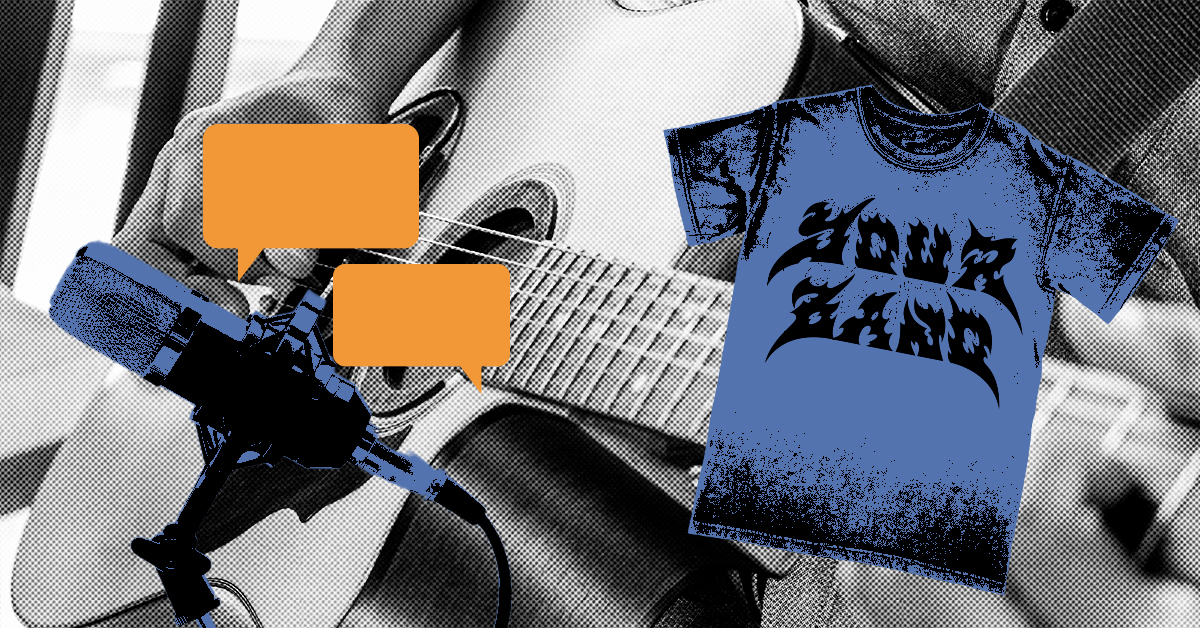In today’s music world, listeners have endless options. Long before they hear your songs, their first impression often comes from what they see on social media, in artwork, or during a performance. A clear and consistent brand helps shape that moment so people remember you and get a sense of your identity. For independent musicians, branding should develop alongside your music and adjust as your audience grows.
Building a Visual Identity That Lasts
Your visual identity is the foundation of your brand, and is often a fan’s first impression of you. A recognizable logo or wordmark, like Nirvana’s iconic smiley logo, for example, can become a signature that fans instantly associate with you. Consistent colors, typography, and imagery across platforms make your work easy to spot. Album and single covers should feel connected to your overall style while still telling the story of that specific release. On stage, lighting, backdrops, and projections can bring the visual identity into the live space. Merchandise allows fans to carry your brand into their everyday lives, keeping it present outside of shows.
Many artists opt to build their brand around defined “eras,” giving each release a unique look and feel while maintaining certain core elements. Taylor Swift has turned this into an art form, designing entire album campaigns with matching themes, visuals, and stage production. Tyler, the Creator approaches each record with a fresh visual concept, from the pastel colors of IGOR to the green palette and visual symbolism of Chromakopia. Billie Eilish transformed from the dark neon tones of When We All Fall Asleep into the softer, vintage-inspired aesthetic of Happier Than Ever. A planned evolution can keep an audience engaged wondering what will come next.
Your Voice Outside of the Music
An artist’s voice connects with audiences outside of the music. The tone you use in social media captions, newsletters, and interviews should authentically reflect your personality and align with your musical style. This tone can be casual, mysterious, direct, or playful, as long as it remains consistent. By sharing personal moments alongside updates about your work, you allow your audience to see the person behind the art. While you may adapt your style for different platforms, the core of your voice should remain constant.
Reneé Rapp is down-to-earth and relatable in both interviews and online posts. Her humor and openness about personal experiences make her audience feel close to her. Megan Thee Stallion’s confidence and sense of humor in her lyrics, posts, and stage presence are key parts of her brand. She also creates genuine connections with her fans through discussing her interests, such as her love of anime, through collaborations with relevant brands and appearances at events like DreamCon.
Extending the Brand to the Stage
Live shows reflect your brand. The way you dress, move, engage with the audience, and design your set all affect how people experience your music. Using consistent elements, like a specific opening song or familiar stage visuals, can create traditions that fans look forward to.
Harry Styles uses bold, colorful fashion and encourages crowd participation, creating a fun environment and community around his shows that keeps fans coming back. Sabrina Carpenter combines polished pop performance with lighthearted audience interactions, building a stage presence that feels like a sleepover with friends just as much as it feels like a live performance.
Creative Collaborations, Videos, and More
Your brand can grow through creative projects outside of recording and touring. Collaborations with other artists, music videos, and short-form content help expand your story. Meeting fans, sharing behind-the-scenes moments, and showing up for community or cause-related events can all deepen your connection with your audience.
Michael Jackson built a global image through cinematic music videos, signature choreography, and charitable work that extended far beyond his albums. Lady Gaga has expanded her artistry into acting, fashion, and advocacy, using each to strengthen her creative identity and connect with people in different spaces.
Keeping Things Consistent and Evolving
Strong branding should be consistent but still allow for growth. A straightforward guide for visuals, tone, and themes helps keep everything on track. As your sound changes, your brand can also adapt while still feeling familiar to your audience.
The Beatles exemplify musical evolution, transitioning seamlessly from early rock and roll to psychedelic experimentation and later, heartfelt songwriting. Each change was a thoughtful journey that preserved their unique identity, allowing them to connect deeply with longtime fans and new listeners.
Branding is part of telling your story as an artist. Every song, performance, piece of artwork, and fan interaction contributes to the world you create around your music. The more precise and consistent the world is, the easier it is for listeners to connect with it and want to stay a part of it.

